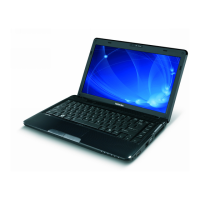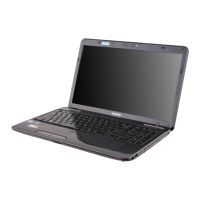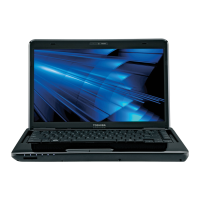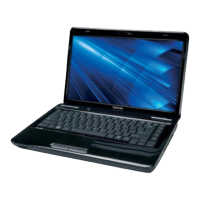
Do you have a question about the Toshiba Satellite L630 and is the answer not in the manual?
| Bus type | DMI |
|---|---|
| Stepping | K0 |
| Tjunction | 90 °C |
| Processor cache | 3 MB |
| Processor cores | 2 |
| System bus rate | 2.5 GT/s |
| Processor family | Intel® Pentium® |
| Processor series | Intel Pentium P6000 Series for Mobile |
| Processor socket | PGA988 |
| Processor codename | Arrandale |
| Processing Die size | 81 mm² |
| Processor frequency | 2 GHz |
| Processor cache type | Smart Cache |
| Processor lithography | 32 nm |
| Processor manufacturer | Intel |
| Processor front side bus | - MHz |
| PCI Express slots version | 2.0 |
| Processor operating modes | 32-bit, 64-bit |
| ECC supported by processor | No |
| PCI Express configurations | 1x16 |
| Thermal Design Power (TDP) | 35 W |
| CPU multiplier (bus/core ratio) | 15 |
| Maximum number of PCI Express lanes | 1 |
| Number of Processing Die Transistors | 382 M |
| Motherboard chipset | Intel® HM55 Express |
| HDD speed | 5400 RPM |
| HDD interface | SATA |
| Storage media | HDD |
| Optical drive type | DVD Super Multi |
| Card reader integrated | Yes |
| Total storage capacity | 320 GB |
| Compatible memory cards | Memory Stick (MS), MMC, MS PRO, SD |
| Display diagonal | 13.3 \ |
| Display resolution | 1366 x 768 pixels |
| Native aspect ratio | 16:9 |
| Power supply type | AC/DC |
| Power requirements | 100 - 240 V |
| Compliance industry standards | IEEE 802.3, IEEE 802.3u |
| Memory slots | 2x SO-DIMM |
| Internal memory | 4 GB |
| Memory clock speed | 1066 MHz |
| Internal memory type | DDR3-SDRAM |
| Maximum internal memory | 8 GB |
| Discrete graphics card model | Not available |
| On-board graphics card model | Intel® HD Graphics |
| On-board graphics card base frequency | 500 MHz |
| On-board graphics card dynamic frequency (max) | 667 MHz |
| Audio system | Dolby Advanced |
| Keyboard layout | Alphanumeric |
| Pointing device | Touchpad |
| Front camera resolution (numeric) | 0.3 MP |
| Wi-Fi standards | 802.11b, 802.11g, Wi-Fi 4 (802.11n) |
| Cabling technology | 10/100Base-T(X) |
| Networking features | Fast Ethernet |
| Operating system installed | Windows 7 Home Premium |
| Charging port type | DC-in jack |
| USB 2.0 ports quantity | USB 2.0 ports have a data transmission speed of 480 Mbps, and are backwards compatible with USB 1.1 ports. You can connect all kinds of peripheral devices to them. |
| Firewire (IEEE 1394) ports | 0 |
| Cable lock slot type | Kensington |
| Password protection type | HDD, Supervisor, User |
| Battery life (max) | 4.25 h |
| Product color | Black |
| Processor code | SLBUR |
| Processor ARK ID | 50175 |
| Processor package size | 37.5x37.5 mm |
| Graphics & IMC lithography | 45 nm |
| Physical Address Extension (PAE) | 36 bit |
| Depth | 221 mm |
|---|---|
| Width | 329 mm |
| Weight | 2100 g |
| Height (rear) | 36.9 mm |
| Height (front) | 27.9 mm |
Details the types of safety messages used in the manual and general safety precautions for maintenance.
Provides procedures for diagnosing and resolving FRU (Field Replaceable Unit) problems.
Explains diagnostic programs to test and diagnose hardware component functions.
Details the steps for disassembling the computer and replacing Field Replaceable Units (FRUs).
Troubleshooting steps for power supply issues, including LED status and connections.
Procedures for diagnosing potential defects or malfunctions of the system board.
Troubleshooting steps for diagnosing issues with the Hard Disk Drive (HDD).
Procedures for checking and troubleshooting keyboard defects or malfunctions.
Steps for diagnosing display issues, including external monitor checks and cable connections.
Troubleshooting procedures for the Optical Disk Drive (ODD), including cleaning and connector checks.
Procedures for checking LAN card functionality and troubleshooting connection issues.
Steps for troubleshooting audio system defects, including connector checks.
Procedures for diagnosing issues with the cooling module, including fan and connection checks.
Lists and explains error codes related to CPU, Memory, Board, FAN, Video, Audio, LAN, and Keyboard.
Explains how to disassemble the computer and replace Field Replaceable Units (FRUs), including safety precautions.
Detailed steps for removing and installing the system board, with caution for PC card eject button.
Procedures for removing and installing the thermal module (cooling system), including silicon grease application.
Instructions for safely removing and installing the CPU, including socket handling.











